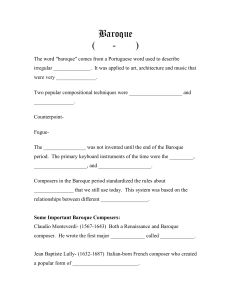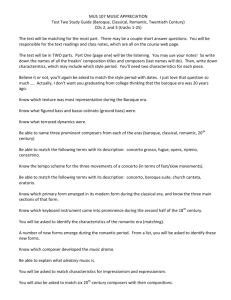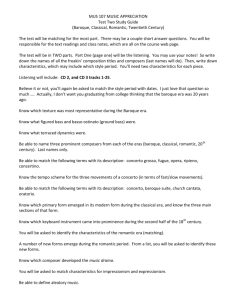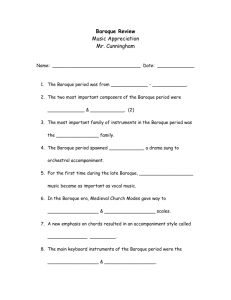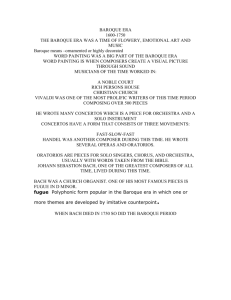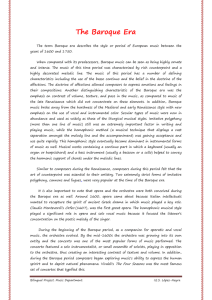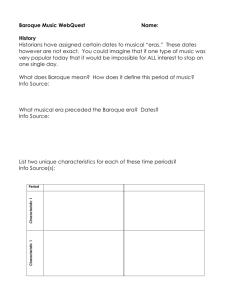Baroque (1600 – 1750)
advertisement
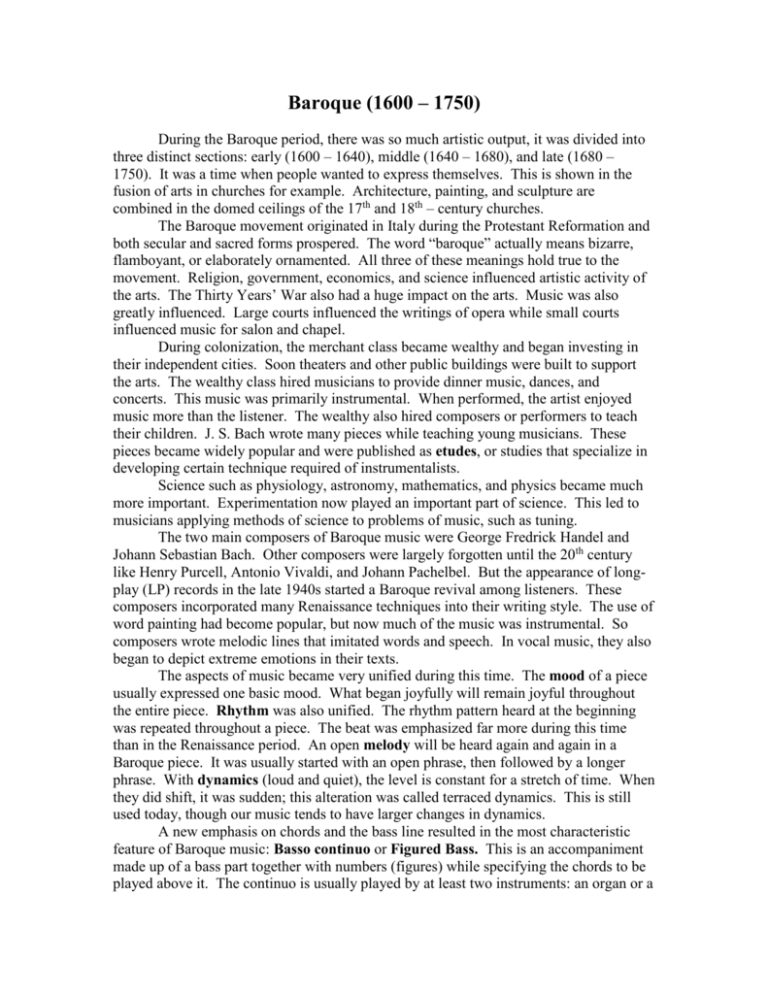
Baroque (1600 – 1750) During the Baroque period, there was so much artistic output, it was divided into three distinct sections: early (1600 – 1640), middle (1640 – 1680), and late (1680 – 1750). It was a time when people wanted to express themselves. This is shown in the fusion of arts in churches for example. Architecture, painting, and sculpture are combined in the domed ceilings of the 17th and 18th – century churches. The Baroque movement originated in Italy during the Protestant Reformation and both secular and sacred forms prospered. The word “baroque” actually means bizarre, flamboyant, or elaborately ornamented. All three of these meanings hold true to the movement. Religion, government, economics, and science influenced artistic activity of the arts. The Thirty Years’ War also had a huge impact on the arts. Music was also greatly influenced. Large courts influenced the writings of opera while small courts influenced music for salon and chapel. During colonization, the merchant class became wealthy and began investing in their independent cities. Soon theaters and other public buildings were built to support the arts. The wealthy class hired musicians to provide dinner music, dances, and concerts. This music was primarily instrumental. When performed, the artist enjoyed music more than the listener. The wealthy also hired composers or performers to teach their children. J. S. Bach wrote many pieces while teaching young musicians. These pieces became widely popular and were published as etudes, or studies that specialize in developing certain technique required of instrumentalists. Science such as physiology, astronomy, mathematics, and physics became much more important. Experimentation now played an important part of science. This led to musicians applying methods of science to problems of music, such as tuning. The two main composers of Baroque music were George Fredrick Handel and Johann Sebastian Bach. Other composers were largely forgotten until the 20th century like Henry Purcell, Antonio Vivaldi, and Johann Pachelbel. But the appearance of longplay (LP) records in the late 1940s started a Baroque revival among listeners. These composers incorporated many Renaissance techniques into their writing style. The use of word painting had become popular, but now much of the music was instrumental. So composers wrote melodic lines that imitated words and speech. In vocal music, they also began to depict extreme emotions in their texts. The aspects of music became very unified during this time. The mood of a piece usually expressed one basic mood. What began joyfully will remain joyful throughout the entire piece. Rhythm was also unified. The rhythm pattern heard at the beginning was repeated throughout a piece. The beat was emphasized far more during this time than in the Renaissance period. An open melody will be heard again and again in a Baroque piece. It was usually started with an open phrase, then followed by a longer phrase. With dynamics (loud and quiet), the level is constant for a stretch of time. When they did shift, it was sudden; this alteration was called terraced dynamics. This is still used today, though our music tends to have larger changes in dynamics. A new emphasis on chords and the bass line resulted in the most characteristic feature of Baroque music: Basso continuo or Figured Bass. This is an accompaniment made up of a bass part together with numbers (figures) while specifying the chords to be played above it. The continuo is usually played by at least two instruments: an organ or a harpsichord and a low melodic instrument like the cello or bassoon. Since it is loosely written, the performer has much freedom. This technique also saved time and paper which were very expensive at this time. Form was very important during the Baroque period. Pieces such as the concerto, cantata, opera, and the oratorio developed from specific forms. One form found only in the Baroque period is the use of Ground Bass. This is when a musical idea in the bass is repeated over and over while the melodies above it constantly change. It may be as short as four notes or as long as eight measures. This gives unity to the piece, while the free flow of the melodic lines above it results in variety. Early Baroque (1600 – 1640):Vocal music is still very dominant. Composers favored Homophonic (chordal) textures over polyphonic texture. They felt that words could be projected more clearly by using just one main melody with chordal accompaniment. Composers: Girolamo Frescobaldi: Italian composer and organist: the most influential keyboard composer of the first half of the 17th century; not a cultured man, described as “all knowledge being at the end of his fingertips.” His was well-knowned for his keyboard music and madrigals. Middle Baroque (1640 – 1680): Major and minor scales developed during this time; Instrumental music gains importance, especially musicfor strings and keyboard instruments like the organ and harpsichord. Composers: Johann Pachelbel (1653-1706): German organist and composer; wrote mainly organ works, but mostly known for his fugues because of their intrinsic artistic value. Henry Purcell (1659-1695): called the greatest of English composers; at the early age of 20, he became the organist at the esteemed Westminster Abbey, where he was later buried; he was the last native English composer of international recognition until the 20th century; he wrote church music, secular choral music, music for small groups of instruments, songs, and music for the stage; his only opera for which his is most famous is Dido and Aeneas, considered by most to be the finest opera ever written to an English text. Late Baroque (1680 – 1750):Polyphonic texture had returned to favor among composers; Composers: Antonio Vivaldi (1678-1741): teacher, composer, and conductor at the music school of the Pieta, an all-girls school in Venice; along with musical training, he also prepared for priesthood and known as the “Red Priest” because of his red hair; his popularity waned shortly before his death, dying in poverty, acclaimed in his lifetime, but he was forgotten until the mid 1900s, when their was actually a Vivaldi revival. Johann Sebastian Bach (1685-1750): master organist; spent his entire life in Germany; by the time he could walk, he was playing the violin; spent his early childhood copying scores by Johann Pachelbel; at age 15, went to St. Michael’s, a school of music; at age 18, he was considered a master of music; had 20 children between two marriages; at one point in his life, he was in charge of four churches at once and wrote one cantata for every Sunday service for five years; went blind late in life and eventually died of a cerebral hemorrhage. George Fredrick Handel (1685-1759): master of Italian opera and English oratorio; born in Germany one month before Bach; not from a musical family; during the years 1712-1759, he became England’s most important composer and a favorite of Queen Anne; In 1741, the year he composed the Messiah, he stopped writing operas entirely and wrote only oratorios; went blind late in life; 3000 mourners attended his funeral. Messiah (1741): Handel’s most famous oratorio; it is composed of three main sections: 1. Prophecy of the Messiah’s coming 2. Redemption by the sacrifice of Jesus 3. Certainty of eternal life through Christ It uses text from both the new and the old testament; it is meditative rather than dramatic, lacking plot, action, and specific characters; made up of over 50 movements that last a total of about 2.5 hours. It only took Handel 24 days to complete this work, though much of it was later arranged by Wolfgang Amadeus Mozart. Definitions 1. Baroque: “Bizarre” era from 1600-1750. 2. Fugue: polyphonic composition based on one theme, or subject. 3. Oratorio: large-scale composition for chorus, vocal soloists, and orchestra, usually set to a narrative text, but without acting, scenery, or costumes; often based on biblical stories. 4. Cantata: composition for solo voice, containing recitatives and arias; musical sermon. 5. Concerto: piece for solo and orchestra accompaniment. 6. Concerto Grosso: small group of soloists with orchestra accompaniment. 7. Figured Bass: accompaniment made up of a bass part together with numbers which specify the chords to be played above it. 8. Canon: several voices/instruments have the same melody, but enter at different times or sing at different speeds simultaneously. 9. Ground Bass: the bass is repeated over and over while the melody above it constantly changes. 10. Aria: songful monologue or duet in an opera or other vocal work like the cantata. 11. Opera: drama that is sung to orchestral accompaniment, usually a larg scale work using vocal soloists, chorus, orchestra, costumes, and scenery. 12. Harpsichord: a stringed keyboard instrument in use from the 16th through 18th century. 13. Lute: guitar-like instrument that was very popular during the Renaissance period.

